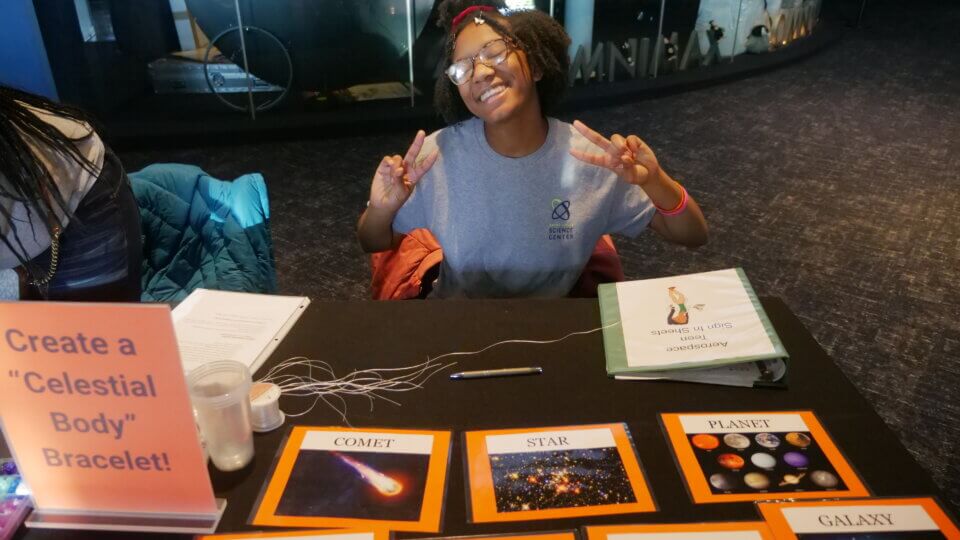Color Lithograph – NASA, 2016 In honor of Black History Month, we are highlighting artifacts like this lithograph produced by NASA featuring women of color in aviation and space history. Portraits of these women pioneers and innovators who have been, or are currently, in the fields of aeronautics and astronautics illustrate the important roles these… Continue reading
Astronomy Fact of the Day: February 7, 2023
February 7, 2023 For the next two weeks, northern hemisphere viewers have a chance to see the zodiacal light in the west after evening twilight. The zodiacal light is a wedge-shaped diffuse light that points up from the horizon. This light display is caused by sunlight reflecting off dust in the solar system. Recent studies… Continue reading
Astronomy Fact of the Day: February 6, 2023
February 6, 2023 On this date in 1971, Apollo 13 astronaut, Alan Shepard, became the first person to hit a golf ball on the Moon. He used a 6-iron head attached to a lunar sampling tool. He hit two golf balls, the second of which went “miles and miles” according to Shepard. Later imagery analysis… Continue reading
Night Sky Update: February 3 – 11, 2023
This is the Saint Louis Science Center’s NIGHT SKY UPDATE for the week of Friday, February 3, 2023. Information updated weekly or as needed. Times given as local St. Louis time which is Central Standard Time (CST). For definitions of terminology used in the night sky update, click the highlighted text. If relying on times… Continue reading
Astronomy Fact of the Day: February 5, 2023
February 5, 2023 A full moon occurs today at 12:28 pm CST. As the Moon is at apogee – the farthest point from Earth in its orbit, the Moon will be slightly smaller in appearance than average. The apparent difference in size will be undetectable to the human eye; however, this will be the smallest… Continue reading
Astronomy Fact of the Day: February 4, 2023
February 4, 2023 Tonight at 7:30 pm CST, it is possible to find the Moon, Mars, and Jupiter in the sky. The Moon will be visible to the east in the constellation Cancer, Mars is found to the south in Taurus, and Jupiter will be visible to the west-southwest in Pisces. Although the Moon will… Continue reading
Astronomy Fact of the Day: February 3, 2023
February 3, 2023 On this date in 1966, the uncrewed Soviet probe Luna 9 became the first man-made object to make a soft landing on the Moon. Although the images taken by Luna 9 were not immediately released by the Soviet Union, British astronomers used standard radiofax technology of the time to intercept the image… Continue reading
Discovering the Diversity in STEAM at the Community STEAM Showcase
Support science for our future. Make a gift to the Science Center’s YES Program to help support the Science Center’s education programs. Header image photo credit: Harmony Cooper, YES Teen On Saturday, January 14, the Science Center hosted the latest Community STEAM Showcase, welcoming over 4,000 guests of all ages to meet the diverse scientific… Continue reading
Astronomy Fact of the Day: February 2, 2023
February 2, 2023 Tonight at 9 pm CST, it is possible to find the Moon high in the southeastern sky. The Moon will exhibit a waxing gibbous phase and appears approximately 91% illuminated. The line between day and night on the Moon is called the terminator. The southeastern sky as it will appear tonight at… Continue reading
Astronomy Fact of the Day: February 1, 2023
February 1, 2023 Tonight at 8 pm CST, it is possible to find Mars high in the southern sky. Mars will appear very close to the bright orange star Aldebaran. As both Mars and Aldebaran have a reddish-orange appearance it can be hard to differentiate between the two. However, Aldebaran appears to twinkle or scintillate,… Continue reading








